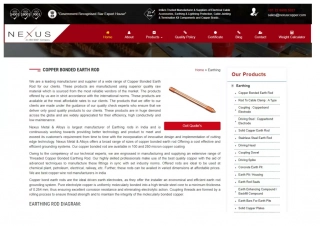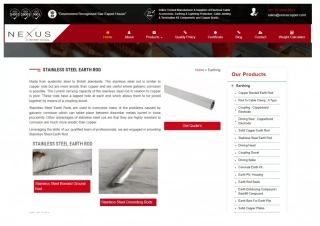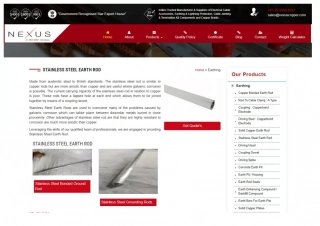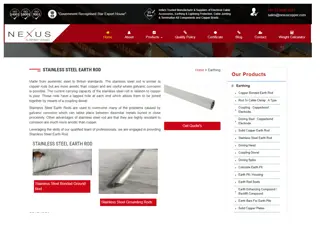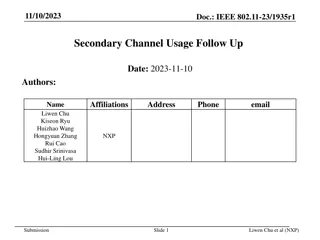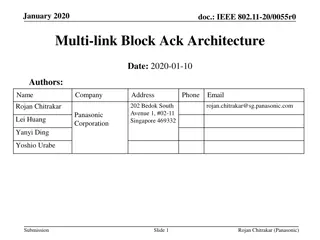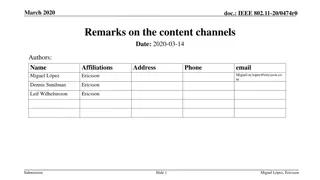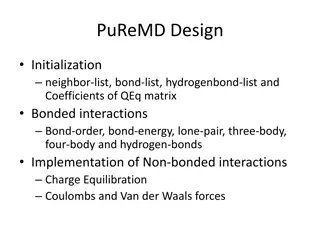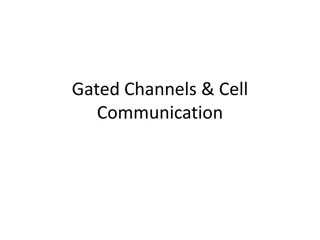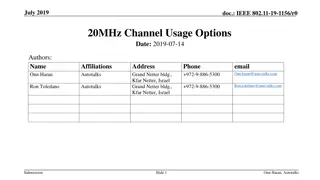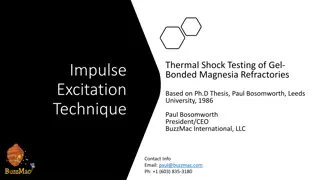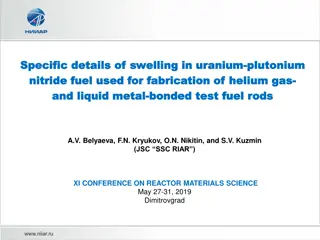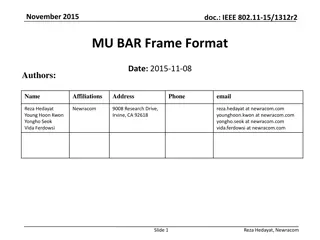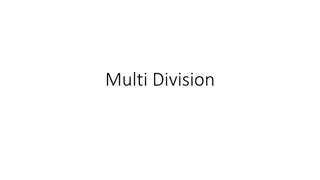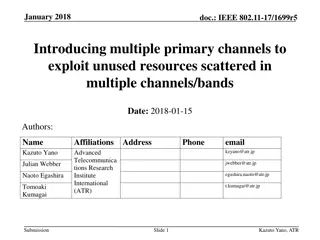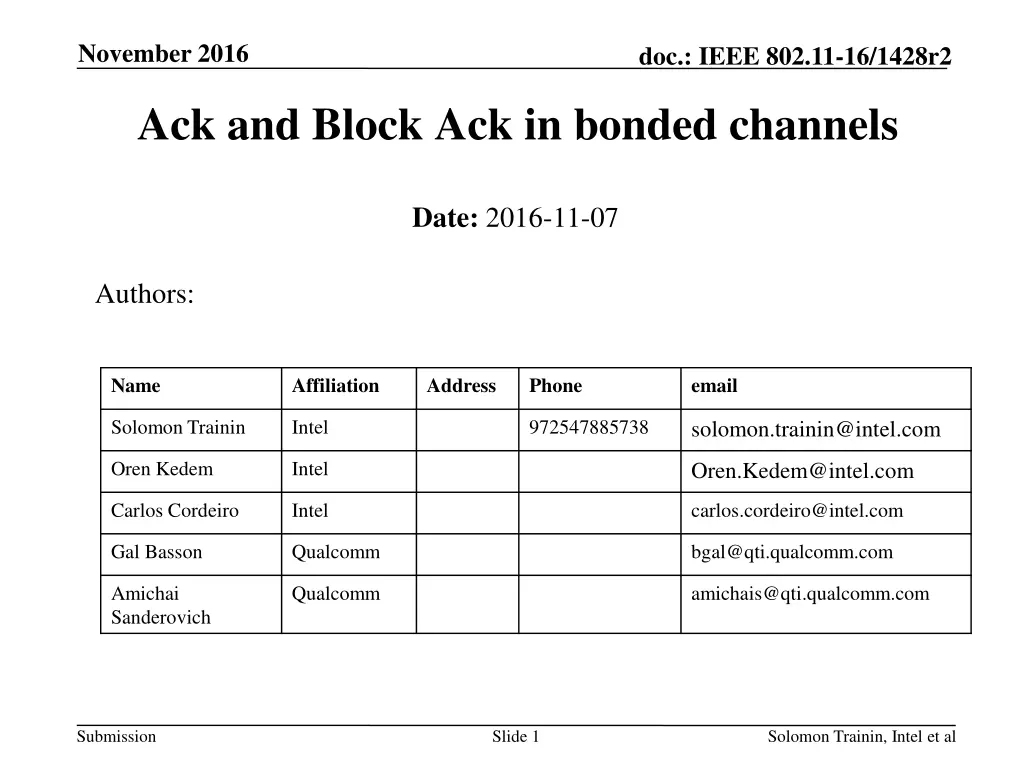
IEEE 802.11-16/1428r2: Ack and Block Ack in Bonded Channels
Explore the presentation slides from November and September 2016 focusing on IEEE 802.11-16/1428r2 protocol aspects related to acknowledgments and block acknowledgments in bonded channels. Discover insights into wideband vs. duplicated formats, BA length comparisons, and considerations for mixed-mode preamble and header transmission. Gain valuable information on bonded vs. duplicate ACK considerations and advertisement of NAV ACK frame transmission time.
Download Presentation

Please find below an Image/Link to download the presentation.
The content on the website is provided AS IS for your information and personal use only. It may not be sold, licensed, or shared on other websites without obtaining consent from the author. If you encounter any issues during the download, it is possible that the publisher has removed the file from their server.
You are allowed to download the files provided on this website for personal or commercial use, subject to the condition that they are used lawfully. All files are the property of their respective owners.
The content on the website is provided AS IS for your information and personal use only. It may not be sold, licensed, or shared on other websites without obtaining consent from the author.
E N D
Presentation Transcript
November 2016 doc.: IEEE 802.11-16/1428r2 Ack and Block Ack in bonded channels Date: 2016-11-07 Authors: Name Affiliation Address Phone email Solomon Trainin Intel 972547885738 solomon.trainin@intel.com Oren Kedem Intel Oren.Kedem@intel.com Carlos Cordeiro Intel carlos.cordeiro@intel.com Gal Basson Qualcomm bgal@qti.qualcomm.com Amichai Sanderovich Qualcomm amichais@qti.qualcomm.com Submission Slide 1 Solomon Trainin, Intel et al
November 2016 doc.: IEEE 802.11-16/1428r2 Purpose and definitions Purpose of this presentation is to provide Ack and BA rules for bonded channels Submission Slide 2 Solomon Trainin, Intel et al
September 2016 Bonded vs. Duplicate ACK consideration doc.: IEEE 802.11-16/1428r2 Advertisement of NAV ACK frame transmission time Link budget Submission Slide 3 Solomon Trainin, Intel et al
November 2016 doc.: IEEE 802.11-16/1428r2 Tx Sequence in multiple channels and NAV setup Mixed mode preamble and header ACK/BA wideband vs. duplicated Tx Sequence in multiple channels BW allocation from 2016-TECH-Intel-0031-01- NG60 channel bonding more details r1 R T S T r l STA A CH1 P Data C T S T r l STA B R T S T r l STA A STA B CH2 C T S T r l CH1 P NAV STA C CH2 Duplicated RTS/CTS allows STA C to set up NAV ACK/BA in duplicated mode allows STA C to set up NAV Submission Slide 4 Solomon Trainin, Intel et al
November 2016 doc.: IEEE 802.11-16/1428r2 BA length wideband vs duplicated MCS1 Bitmap size (bit) BA size (byte) BA length (us) Duplicate Bonded (BW=2) Capacity in BW=2(byte) 64 33 3.382 4.591 47 128 41 3.382 4.591 256 67 4.255 4.882 99 512 89 4.838 4.882 1024 153 6.000 5.464 154 MCS1 Bitmap size (bit) BA size (byte) BA length (us) Duplicate Bonded (BW=3) Capacity in BW=3(byte) 64 33 3.382 4.591 73 128 41 3.382 4.591 256 67 4.255 4.591 512 89 4.838 4.882 161 1024 153 6.000 4.882 Submission Slide 5 Solomon Trainin, Intel et al
November 2016 doc.: IEEE 802.11-16/1428r2 ACK and BA wideband vs duplicated Format Pros Cons Consequences Comments Wideband BA is shorter for MCS 1 and bitmap size of 1024 bits Duration field is not available for NAV assertion of legacy STA, non multichannel capable STA, and STA that are not open for same BW Duration field can be received by any EDMG STA opened to equal or wider BW with any primary channel Tx Sequence in multiple channels BW allocation from 2016-TECH-Intel-0031-01- NG60 channel bonding more details r1 1.NAV can be set by legacy and non multichannel capable STA 2.Ack is shorter 3.BA is shorter in most cases Duplicated MCS1 and 1024 bitmap is not shorter Support of duplicate Tx mode for mandatory MCS s Same as above Submission Slide 6 Solomon Trainin, Intel et al
September 2016 Duplicated mode vs. wide bonded channel link budget doc.: IEEE 802.11-16/1428r2 Trade off between using duplicated (D) or wide (W) bonded mode 1. In D, only half the power is useful 2. In W, receiver integrates twice as much noise 1) and 2) above more or less cancel each other However, in D a larger BO will be needed due to larger PAPR Considering all of the above to a worse link budget the duplicated mode leads Submission Slide 7 Solomon Trainin, Intel et al
November 2016 Comparing MCS5 (bonded) vs MCS1 (duplicated) with CB=4 mcs1, duplicate link budget advantage SNR at sensitivity 5.6 MCS1 requires a lower SNR MCS1 receiver integrates noise only over quarter the BW MCS1 only quarter of the signal power is used by receiver Both are BPSK MCS1 duplicate PAPR is approx. 6 dB larger, but 6 dB larger EVM is allowed, so assume need larger BO of approx. 4 dB Total 1.6 doc.: IEEE 802.11-16/1428r2 Noise BW 6 Useful power -6 BO advantage -4 Summary: when responding in duplicated mode to bonded frame sent by an MCS that is higher or equal to 5, sending the response frame with MCS1 compensates the link budget deficiency. Submission Slide 8 Solomon Trainin, Intel et al
September 2016 Wideband vs duplicated, response decision making Data frame BW=2channels doc.: IEEE 802.11-16/1428r2 Data frame MCS Data frame BW=3channels ACK/BA by mandatory MCS 1 2 NA W W D D D 3 4 Data frame MCS 1 2 3 4 5 6 7 8 9 W W W D D D NA NA W W D D NA NA NA W W D ACK/BA by mandatory MCS 1 2 W NA W W W W D W D D D D D D Mandatory MCS Data frame BW=4channels 3 4 1 2 3 4 5 6 7 8 9 NA NA W W W D D NA NA NA W W W D Data frame MCS Mandatory ACK/BA by mandatory MCS 1 2 W NA W W W W W W D W D D D D D D MCS 3 4 1 2 3 4 5 6 7 8 9 NA NA W W W W D D NA NA NA W W W W D Mandatory MCS Submission Slide 9 Solomon Trainin, Intel et al
November 2016 doc.: IEEE 802.11-16/1428r2 Straw Poll An ACK or BA frame shall be sent over a bandwidth equal to the bandwidth of the frame the ACK or BA are sent in response to. An ACK or BA frame sent in duplicated mode in response to a 4.32 GHz, 6.48 GHz, or 8.64 GHz PPDU received with an MCS higher than MCS4 shall be sent with MCS1 An ACK or BA frame transmitted in response to a 4.32 GHz, 6.48 GHz or 8.64 GHz PPDU received with an MCS lower than or equal to MCS4 may be sent in non-duplicated mode with the same bandwidth of the PPDU the frame is sent in response to, and with an MCS that is equal or lower than the MCS of the PPDU that the ACK and BA are sent in response to and that provides the shortest response frame length Submission Slide 10 Solomon Trainin, Intel et al
November 2016 doc.: IEEE 802.11-16/1428r2 BACKUP Submission Slide 11 Solomon Trainin, Intel et al
November 2016 BA length wideband vs duplicated (cont.) doc.: IEEE 802.11-16/1428r2 MCS1 Bitmap size (bit) BA size (byte) BA length (us) Duplicate Bonded (BW=4) Capacity in BW=4(byte) 64 33 3.382 4.591 99 128 41 3.382 4.591 256 67 4.255 4.591 512 89 4.838 4.591 1024 153 6.000 4.882 203 Submission Slide 12 Solomon Trainin, Intel et al

